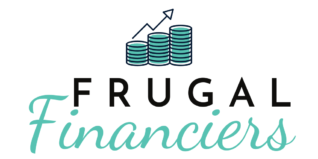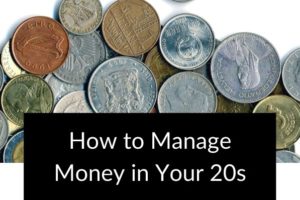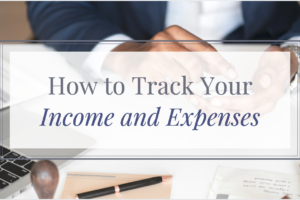After you’ve created a way to track your income and expenses, the next step of organizing your finances is to categorize your expenses.
You want to keep this as simple as possible while still getting valuable information.
The easier it is to categorize your transactions, the more likely you’ll consistently keep track of your finances.
This involves first categorizing your expenses as essential expenses or non-essential expenses.
Then, categorizing by groups of similar purchases.
In this post we’ll cover how to do both.
We’ll also cover some of the difficult aspects of categorizing like dealing with credit card payments.
Before You Start to Categorize Your Expenses
Depending on the way that you’re tracking your expenses, you may have some transactions that you don’t need.
That’s because they’ve been already counted in another area.
A good example is credit cards.
You have all of the purchases you’ve made with the credit card.
You also have the money that came out of your bank account to pay off the credit card.
And, finally, you have the money that came into your credit card account.
Unless you’re paying interest each time you make a payment (more info on this below), the money out and in transactions are just extra and you don’t need them.
As you go through your transactions, make sure you’re not double-counting anything.
Credit card payments are the most common.
Starting with Necessities and Non-Necessities
Starting out, you want to go through all of your spending transactions and label them as a necessary expense or a non-necessary expense.
For each purchase, ask yourself:
Would I spend my last dollars on this purchase?
Assume that whatever the purchase amount is, you have just enough money to cover that purchase.
The goal is to separate those purchases that you absolutely need and those purchases that if you had to, you could go without.
Necessities
Your necessary purchases or fixed expenses are all of those purchases that you must make to live.
Here is a list of common essential expenses:
- Housing
- Transportation
- Grocery Store Food
- Utilities
- Insurance
- Basic Clothing
- Tuition and other Student Costs
Non-Necessities
Your non-essential expenses or discretionary spending are all of those purchases that enhance your quality of life.
Here is a list of common essential expenses:
- Dining Out
- Television
- Entertainment
- Clothing
- Memberships
Difficult Expenses to Categorize
There are likely to be a few transactions where you’re not sure if you should put it in the essential or the non-essential category.
For example, there have probably been times when you’ve bought clothing that was considered essential and other times when it would be considered non-essential.
Every person is different so you should go with your gut on a transaction.
If it feels like a non-essential purchase label it as such.
Also, it can be a good idea to write down everything that you think is essential and non-essential.
Remember, the goal is to keep it simple so that it doesn’t feel like a burden every time you categorize your expenses.
Calculate How Much You’re Spending in Each Category
Once you’ve separated your expenses into the two categories, it’s a good time to add up all of the amounts in each category.
The point of categorizing your expenses is to know how much you’re spending in each area.
So, how much do you spend on essentials?
And, how much on non-essentials?
Your essential expenses are pretty much fixed so with the total amount you now have a number that can influence other decisions.
If you’re thinking about building an emergency fund, your fixed expenses are good to keep in mind.
Also, if you’re trying to pay off debt as fast as possible, knowing your essential expenses is a good starting point for how much you can put towards your debt.
For example, your income is $4000 and your necessities are around $2600 so you know that without purchasing anything else, you have $1400 to pay down debt.
Creating Specific Categories
After you’ve separated your expenses into fixed and discretionary expenses, it’s time to do some additional categorization.
You could just stop at essential and non-essential expenses.
But, if your goal is to spend less or know where your money is going with more detail, you’ll see some benefit from creating a set of categories.
It’s all about creating a group for a common set of expenses.
You can even keep all of your essential expenses in one category and just focus on discretionary spending.
Remember try to keep it simple.
What you’re trying to do is understand your spending habits.
So, look through your transactions and see if you can find similarities.
This is going to be a process of grouping and regrouping expenses until you come up with a set of categories that all your expenses can fit in.
Five categories will keep things simple and make categorization go faster but you don’t have as much detail.
Ten categories will be more time-intensive but you’ll have additional detail into where you’re spending your money.
Any more than ten categories, and you’re probably spending too much time categorizing without good additional details.
We use five categories:
- Home
- Groceries/Toiletries
- Personal
- Entertainment
- Miscellaneous
Many different purchases fit in each category.
If we told you to put purchases in each category, you’d probably have a total different system than us.
Here are the five categories with what’s in each category:
- Home: Rent, renter’s insurance, repairs
- Groceries/Toiletries: Food, bathroom, and home supplies
- Personal: Clothing, gifts to other people, health-related expenses
- Entertainment: Dining out, movies, music downloads, books
- Miscellaneous: Transportation, anything that doesn’t fit in those categories
Every set of categories is going to be unique based on what you’re purchasing.
For us, transportation was miscellaneous because we spent almost nothing on it but for other people, transportation expenses could be its own category.
If you’re spending more than 10% of your income on something, it probably should be in its own category.
Creating an “other” or Miscellaneous Category
You’re going to have random expenses.
It’s just a part of life.
Sometimes, they’ll easily fit in a category like a visit to the dentist or doctor fitting into a health or personal category.
But, sometimes you’ll have expenses that don’t really fit into any of your categories.
That’s why it’s good to have a miscellaneous category.
It will be for all of those expenses that don’t really fit anywhere else.
Aim for this category to be less than 10% of your total expenses.
If it’s more than 10%, it’s probably worth looking through and seeing you can create another category.
Wait, but What About Saving and Investing?
You may be wondering why there isn’t a category for saving or investing.
Well, that’s because it isn’t really an expense.
Don’t think of putting money into a savings or investment account like spending money.
Credit Card and Debt Payments
As you’ve been going through your transactions you’ve probably noticed that your bank account has an expense for credit card bills.
There’s also a matching amount incoming for that credit card bill.
You also have all of the transactions for the purchases you made with the credit card.
So, what do you do?
The first thing that you need to do is figure out if you paid any interest.
Your credit card bill will tell you how much you’ve paid in interest and how much in principle you’ve paid down.
If you did pay interest, you’ll want to create a transaction for that expense.
To keep it simple, replace the amount that came out of your bank account with the interest amount.
You can delete the transaction for the incoming money on the credit card.
Now, you should have the transaction for the interest expense as well as all the purchases on the credit card.
If you didn’t pay interest, you can simply delete both the transactions of money going out of your bank account and money going into your credit card account.
The individual transactions already represent the money going out of your bank account and into your credit card account.
Final Thoughts on How to Categorize Expenses
When you start to categorize your expenses, you’ll start to understand your financial picture.
When you’re just out and spending, it can be hard to grasp where you’re spending all of your money.
But, with all of your transactions right in front of you, it’s easy to see where your money is going.
If you want to consistently know your financial situation you’re going to have to consistently track and categorize your expenses.
So, keep it simple.
The easier it is to do, the more likely you are to do it.
And, with that information, you’ll be surprised at how aware you are of your financial situation and spending habits.
Sometimes, just seeing how much you spend on lattes every month will cause you to spend less on lattes.





Leave a Reply
Your email is safe with us.
You must be logged in to post a comment.